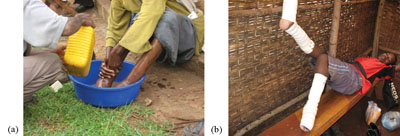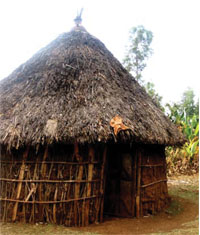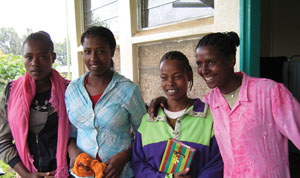39.3.3 Treatment of podoconiosis.
Most people do not know that leg swelling from podoconiosis can be treated – but it can! Using simple foot hygiene, ointment, elastic bandages, socks and shoes, brings improvement to more than nine out of ten patients. They can manage their own foot care if you show them what to do. The basic steps of treatment will be familiar from Study Session 37, but are summarised again briefly here:
- Foot hygiene. First soak the feet for 20 minutes in a basin of cold water into which half a capful (about 10 drops) of berekina (bleach) have been added.
- Then wash the feet carefully using soap and clean cold water (Figure 39.16a). Dry between the toes with a clean cotton cloth.
- Rub a small amount of ointment or oil into the skin after drying.
- For patients with softer swelling of the legs, elastic bandages are useful. Show the patient how to apply the bandage from the toe to the knee, with the leg raised (Figure 39.16b).
 Figure 39.16 (a) Foot hygiene and (b) elastic bandages and raising the legs can greatly improve the symptoms of podoconiosis. (Photos: Gail Davey)
Figure 39.16 (a) Foot hygiene and (b) elastic bandages and raising the legs can greatly improve the symptoms of podoconiosis. (Photos: Gail Davey) - Encourage the patient to perform exercises to improve their circulation, such as toe points, ankle circles and calf raises, two or three times per day.
 Figure 39.17 Houses with earth floors should be covered with mats to prevent soil particles penetrating bare feet. (Photo: Janet Haresnape)
Figure 39.17 Houses with earth floors should be covered with mats to prevent soil particles penetrating bare feet. (Photo: Janet Haresnape) - Raise the affected legs whenever possible by raising the foot end of the bed, or resting the foot on a stool when sitting.
- Clean socks and closed shoes are vital in preventing further exposure to the soil. If local houses have floors made of earth (Figure 39.17), the floor should be covered with mats.
What do you now know about podoconiosis that may also help to break down the stigma that many patients face?
It is not infectious. Podoconiosis can be treated using simple hygiene measures. It can be prevented through regular use of shoes.
Experience in Southern Ethiopia has shown that more than 90% of patients with podoconiosis can be successfully treated without need of referral for care within the government health system. Communities can handle most of the problems that podoconiosis patients have without need for formal healthcare. Seeing young men and women fully treated (Figure 39.18) has a positive impact on the communities that knew them previously as patients.

39.3.2 How does podoconiosis affect people?
